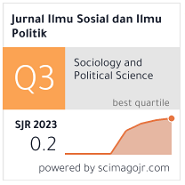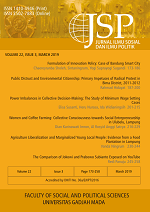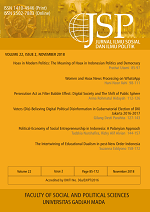Exploring the Terrains of Indonesian Cultural Policy: Learning from Singapore’s and Malaysia’s Experiences
Budi Irawanto(1*)
(1) Faculty of Social and Political Sciences,Gadjah Mada University
(*) Corresponding Author
Abstract
This article seeks to examine Indonesian cultural policy in comparison to Singapore and Malaysia. It focuses particularly on documentary films as a field covered by the cultural policy, which is closely associated with the creative industry. Therefore, this article analyzes various official documents regarding cultural policy and the position documentary films within that policy. While Singapore’s cultural policy is quite comprehensive and visionary in managing and regulating arts and culture, it tends to neglect documentary films as it celebrates commercial feature (fiction) films. Similarly, Malaysian cultural policy pays scant attention to documentary films despite its nationalistic nature. Learning from those two neighboring countries, Indonesia should not only have a comprehensive cultural policy, but also a clear vision on the development of infrastructures while taking into account the fast changing ecology of documentary films in Indonesia.
Keywords
Full Text:
PDFReferences
Arif, P. T. M. (2012). People’ voice: The creative treatment of the actuality in Malaysian Documentary. In J. HC. Yu & Asian Network of Documentary (Eds.), Asian Documentary Today. Busan: Busan International Film Festival.
Aufderheide, P. (2007). Documentary Film: A very short introduction. Oxford: Oxford University Press.
Birch, D. (1996). Film and Cinema in Singapore: Cultural policy as control. In A. Moran (Ed.), Film policy: International, national and regional perspectives (pp.185-2140). London & New York: Routledge
Chong, T. (2005). Singapore’s Cultural Policy and Its Consequences: From Global to Local. Critical Asian Studies, 37(4), 553-568.
De Jong, W. (2012). Creativity. In W. De Jong, E. Knudsen, & J. Rothwel, Creative Documentary: Theory and Practice (pp.9- 17). Edinburg Gate: Pearson.
Florida, R. (2002). The Rise of Creative Class and How it’s Transforming Work Life, Community and Everyday Life. New York: Basic Books.
Hartley, J. (2005). Creative Industries. Oxford: Blackwell.
Hesmondhalgh, D. (2013). The Cultural Industries (3rd Edition). London: Sage.
Infocomm Media Development Authority. (2010). New Feature Film Fund support four new local film. Retrieved from https://www.imda.gov.sg/about/newsroom/ archived/mda/media-releases/2010/ new-feature-film-fund-supports-four-
new-ocal-films.
Jones, T. (2013). Culture, Power, and Authoritarianism in the Indonesian State: Cultural Policy Across the Twentieth Century to Reform Era. London & Leiden: Brill.
Kelly, O. (1996). Digital Creativities. London: Calouste Gulbekian Foundation.
Kementeriaan Kebudayaan, Belia dan Sukan Malaysia. (1973). Asas Kebudayaan Kebangsaan. Kuala Lumpur: Kementeriaan Kebudayaan, Belia dan Sukan Malaysia.
Kementerian Kebudayaan, Kesenian dan Warisan Malaysia. (2005). Dasar Perfileman Malaysia. Kuala Lumpur: Kementerian Kebudayaan, Kesenian dan Warisan Malaysia.
McGuigan, J. (2004). Rethinking cultural policy. Berkshire: Open University Press.
Ministry of Information, Communication and the Arts. (2008). Renaissance City Plan III. Singapore: Ministry of Information, Communication and the Arts.
Moran, A. (1996). Terms for a reader: Film, Hollywood, national cinema, cultural identity and film policy. In A. Moran (Ed.), Film policy: International, national and regional perspectives. (pp.1-22). London & New York: Routledge.
Muthalib, H. (2011). The Films of the Malayan Film Unit in 1950s British Malaya. In: L. Grieveson & C. MacCabe (Eds.), Film and The End of Empire. London: Palgrave& BFI.
Nye Jr, J. (2004). Soft Power: The Means to Success in the World Politics. New York: Public Affairs.
Sarji, A., Ibrahim, F., & Ramlee, S. (2009). Industri Dokumentari di Malaysia: Isu dan Hala Tuju. Ampang: Perbadanan Kemajuan Filem Nasional Malaysia.
Sen, K. (1996). Cinema Polic(y)ing in Indonesia. In A. Moran (Ed.), Film Policy: International, National and Regional Perspectives (pp. 172- 184). London & New York: Routledge.
Tan, P. (2012). Tan Pin Pin, Singapore. In J. HC. Yu & Asian Network of Documentary (Eds.), Asian Documentary Today (pp.317-321). Busan: Busan International Film Festival.
Undang-Undang Republik Indonesia Nomor 33 Tahun 2009 Tentang Perfilman (Indonesian Law No. 33 Year 2009 on Filming). Jakarta: Ministry of Culture and Tourism of the Republic of Indonesia.
Ward, P. (2006). Documentary: The margins of reality. London: Wall Flower.
Article Metrics
Refbacks
- There are currently no refbacks.
Copyright (c) 2017 Jurnal Ilmu Sosial dan Ilmu Politik

This work is licensed under a Creative Commons Attribution-NonCommercial-NoDerivatives 4.0 International License.






















